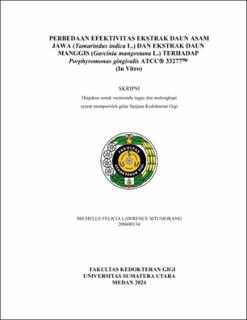| dc.description.abstract | Introduction Tamarind leaves (Tamarindus indica L) are used as traditional
medicine and have bioactive components of saponins, flavonoids, streoids as
antibacterial. Bioactive components of flavonoids, tannins, phenolics as antibacterial.
The overall role of the phytochemicals of tamarind leaves and mangosteen leaves
causes leakage of protein and enzyme functions from within the cell thus damaging
membrane permeability causing bacterial lysis. Porphyromonas gingivalis often
colonizes in the subgingival area causing gingivitis if not treated can cause
periodontitis. Treatment is done with alternative herbs, namely tamarind leaves
extract and mangosteen leaf extract against Porphyromonas gingivalis. Purpose of
the study was determine the inhibitory power, minimum inhibitory concentration
(MIC) and minimum bactericidal concentration (MBC) of tamarind leaf extract and
mangosteen leaf extract. Method is experimental laboratory post test only control
group design. Inhibition testing using blank disk diffusion method with digital
calipers, determination MIC and MBC dilution method. Preparation of extract by
maceration method from each concentration added to bacterial suspension, 4
repetitions and then observations were made. Parametric analysis using Oneway
Anova Test and Post-hoc LSD test with a significance value of p<0.05, if the data
obtained is not normally distributed and homogeneous, non parametric analysis with
Kruskal-Wallis test and Mann Whitney test. The result of the study of the inhibition of
tamarind leaf extract concentrations of 6,25%, 12,5%, 25%, and 50% diameter 15 ±
0.54 mm, 19.56 ± 0.12 mm, 20.93 ± 0.12 mm, and 23.37 ± 0.43, while the inhibition
of mangosteen leaf extract concentrations of 6,25%, 12,5%, 25%, and 50% diameter
0, 10.43 ± 0.433 mm, 14.43 ± 0.31 mm, and 19.19 ± 0.555 mm. The effectiveness of
tamarind leaf extract of several concentrations against Porphyromonas gingivalis
ATCCÒ 33277Ô bacteria is MCI 6.25% and MBC 12,5%, while the effectiveness of
mangosteen leaf extract MCI 6,25% and MBC 50%. Conclusion tamarind leaf extract
is more effective than mangosteen leaf extract against Porphyromonas gingivalis
ATCCÒ 33277Ô bacteria. | en_US |


